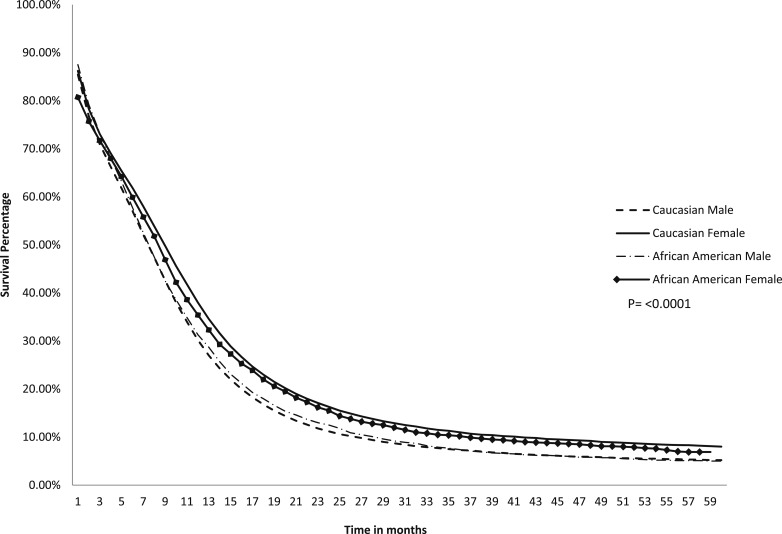To the Editor:
Studies regarding sex and racial differences in small cell lung cancer (SCLC) are limited. We aimed to determine the differences between presentation and outcomes in SCLC between male and female patients among black and white populations using the Surveillance, Epidemiology, and End Results (SEER) data registry 18 from the National Cancer Institute.
A total of 94,7463 patients with lung cancer were identified between 1973 and 2010 (Tables 1, 2). The proportion of SCLC to total lung cancers decreased over the years along with the sex gap; the ratio of men to women decreased from 2.69:1 in 1973 to 1:1 in 2010. The findings were consistent between both black and white patients. The incidence of SCLC compared with all lung cancer was consistently higher in whites compared with the black population. There were no differences in the stage at presentation between blacks and whites (24.17% vs 23.1% presented in limited stage and 53.68% vs 52.55% presented in extensive stage, respectively; P = .343). Women presented with limited-stage disease more often than men (26.28% vs 20.75%, respectively; P ≤ .0001); this difference was consistent in white (26.22% vs 20.4%, P < .0001) as well as black subgroups (26.79% vs 22.15%, P = .0184). Blacks presented at a younger age compared with whites. Some 48.45% of blacks presented with SCLC before the age of 65 years compared with 39.49% of whites. There were no differences in the age of presentation between sexes in either blacks or whites. Although there were no differences in mortality between races, survival analysis showed that women had a better cancer-specific survival than men (Kaplan-Meier curves) (Fig 1). This finding was consistent in both whites and blacks (P ≤ .0001).
TABLE 1 ] .
Sex and Race of Patients With SCLC in SEER Registry 1973-2010
| SCLC | White | Black | Percentage |
| Male | 61,316 | 5,882 | 54.4 |
| Female | 52,946 | 4,512 | 45.6 |
SCLC = small cell lung cancer; SEER = Surveillance, Epidemiology, and End Results.
TABLE 2 ] .
Race of Patients With SCLC and NSCLC in SEER Registry 1973-2010
| Lung Cancer | White | Black | Total |
| SCLC | 113,937 | 10,349 | 124,286 |
| NSCLC | 675,609 | 88,702 | 764,311 |
NSCLC = non-small cell lung cancer. See Table 1 legend for expansion of other abbreviations.
Figure 1 –
Kaplan-Meier survival curves of racial and sex differences in small cell lung cancer in the Surveillance, Epidemiology, and End Results (SEER) Registry: 1973 to 2010.
Our analysis of the SEER database for the years 1973 to 2010 suggests that the incidence of SCLC has been decreasing over the years in both black and white populations, but the incidence of SCLC in women is increasing compared with men. We speculate that these results could be due to changes in smoking habits over time. The percentage of smokers has decreased over the years,1 but the prevalence of female smokers has been increasing.2 There were no significant differences in mortality between races, but when comparing sex, women have a better survival, which could be explained partially by being presented at an earlier stage compared with men.3 Other studies have shown that female sex is a favorable prognostic factor independent of age, performance status, stage, and presence of metastases.4,5
SCLC remains a disease with poor prognosis and high mortality. Further studies on epidemiology of SCLC may help understand pathogenesis and eventually lead to improved survival.
Acknowledgments
Role of sponsors: The sponsors had no role in the design of the study, the collection and analysis of the data, or the preparation of the manuscript.
Footnotes
This study was presented at CHEST 2010 in Vancouver, BC, Canada and published in abstract form (Eskandar AM, Sirop S, Arora S. Chest. 2010;138(4_MeetingAbstracts):726A).
FINANCIAL/NONFINANCIAL DISCLOSURES: The authors have reported to CHEST that no potential conflicts of interest exist with any companies/organizations whose products or services may be discussed in this article.
FUNDING/SUPPORT: This work was made possible with support from the Oregon Clinical and Translational Research Institute (OCTRI) and from the National Center for Advancing Translational Sciences [Grant UL1 RR024140], a component of the National Institutes of Health (NIH), and NIH Roadmap for Medical Research.
Reproduction of this article is prohibited without written permission from the American College of Chest Physicians. See online for more details.
Contributor Information
Ali Eskandar, Flint, MI.
Molly Daughtey, Portland, OR.
Saad Kenderian, Rochester, MN.
Feras Mahdi, Beirut, Lebanon.
Akram Khan, Portland, OR.
References
- 1.Centers for Disease Control and Prevention (CDC). Vital signs: current cigarette smoking among adults aged ≥18 years—United States, 2005-2010. MMWR Morb Mortal Wkly Rep. 2011;60(35):1207-1212. [PubMed] [Google Scholar]
- 2.Jemal A, Thun MJ, Ries LA, et al. Annual report to the nation on the status of cancer, 1975-2005, featuring trends in lung cancer, tobacco use, and tobacco control. J Natl Cancer Inst. 2008;100(23):1672-1694. [DOI] [PMC free article] [PubMed] [Google Scholar]
- 3.Ferguson MK, Skosey C, Hoffman PC, Golomb HM. Sex-associated differences in presentation and survival in patients with lung cancer. J Clin Oncol. 1990;8(8):1402-1407. [DOI] [PubMed] [Google Scholar]
- 4.Spiegelman D, Maurer LH, Ware JH, et al. Prognostic factors in small-cell carcinoma of the lung: an analysis of 1,521 patients. J Clin Oncol. 1989;7(3):344-354. [DOI] [PubMed] [Google Scholar]
- 5.Wheatley-Price P, Ma C, Ashcroft LF, et al. The strength of female sex as a prognostic factor in small-cell lung cancer: a pooled analysis of chemotherapy trials from the Manchester Lung Group and Medical Research Council Clinical Trials Unit. Ann Oncol. 2010;21(2):232-237. [DOI] [PubMed] [Google Scholar]



